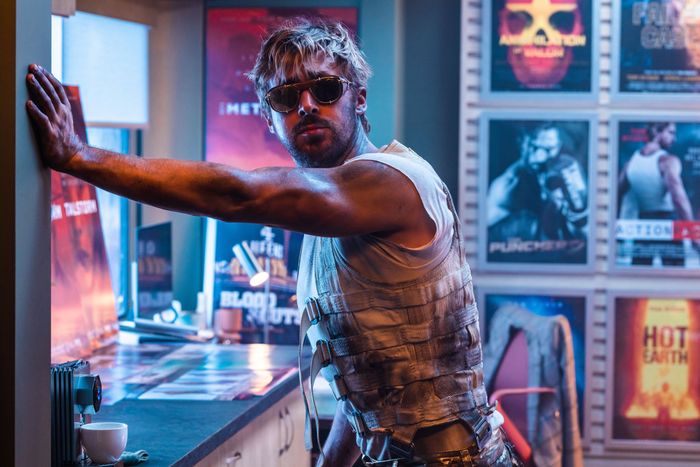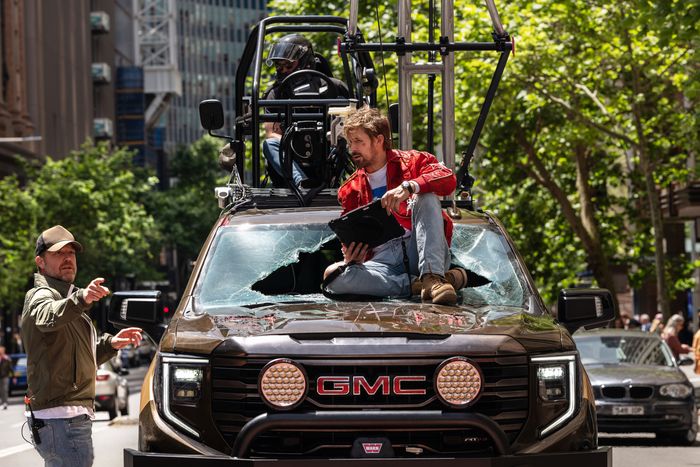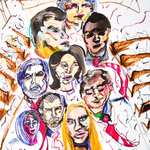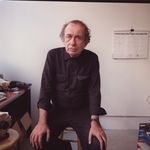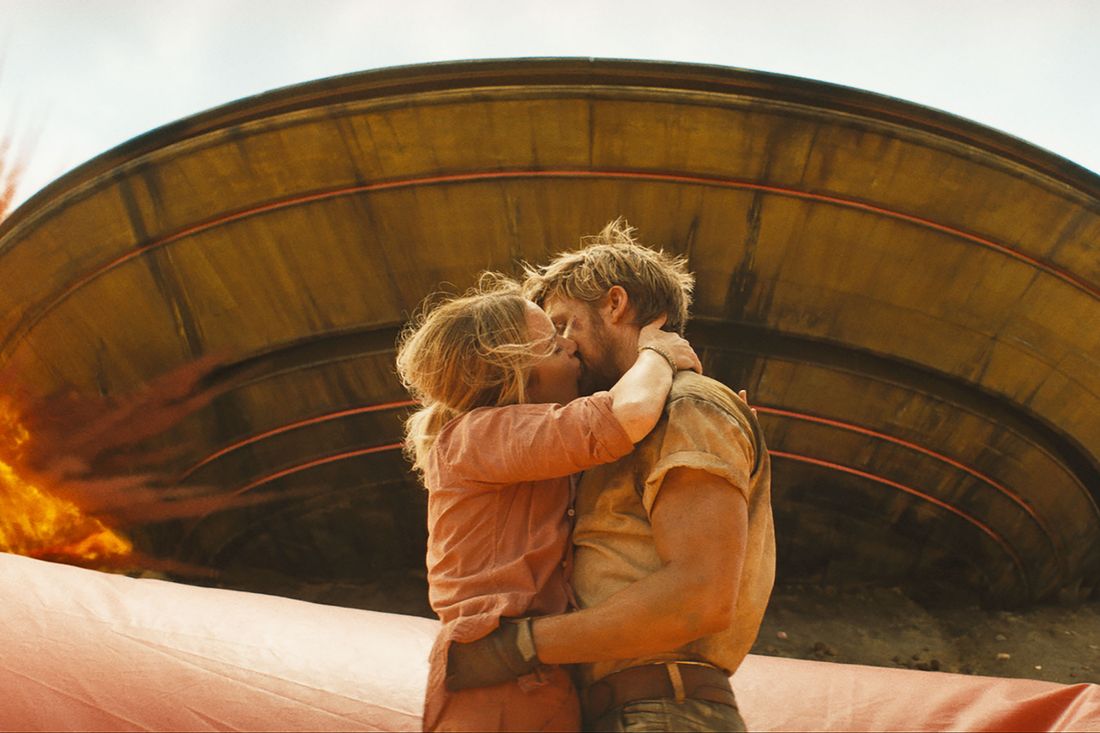
You would not expect a big action flick called The Fall Guy to also be one of the more intimate and romantic movies of the year. Based on the cult 1980s Lee Majors TV show, David Leitch’s film follows a down-on-his-luck stuntman pulled into a missing-persons case on the Sydney set of a sci-fi blockbuster. It showcases some of the most impressive stunts in recent movie history, all filmed with style and gusto by Leitch (who directed movies like John Wick, Atomic Blonde, and Deadpool 2, after a career as a stunt double and stunt coordinator). And yet, walking out of the movie, you might find yourself thinking more about its quieter moments of yearning, built around the simmering chemistry of leads Ryan Gosling and Emily Blunt.
Gosling plays Colt Seavers, an acclaimed stunt double who dropped out of the industry after nearly breaking his back due to an on-set mishap. Blunt plays Jody Moreno, a former camera assistant who was in the midst of a torrid on-set romance with Colt when he got injured and disappeared from her life. She’s now gotten the chance to direct a big-time sci-fi action epic called Metalstorm when Colt reappears. They’re clearly still in love with each other, but she’s furious with him, and he’s still beating himself up over how he ghosted her. It might be an action movie, but The Fall Guy lets their romance dictate its rhythms and mood: Just about every chase or fight becomes, on some level, about trying to reunite Colt and Jody. The love story doesn’t feel extraneous, the way it might in so many other action spectacles; it’s the driving force behind the whole movie.
This is even more remarkable when one looks at just how the picture got made. There have been many attempts over the years to turn the ABC series into a movie. Producer Guymon Casady had convinced the show’s creator, Glen A. Larson, to give him the film rights back in the early 2000s. For a while, Nicolas Cage was attached, with Casino Royale’s Martin Campbell directing. In 2013 came the announcement that, no, it would star the Rock, with McG directing. Neither of those films happened. In 2020, Casady reacquired the rights and approached Leitch and his wife and producing partner, Kelly McCormick. They leapt at the chance to make a movie out of a show that had been instrumental in kicking off Leitch’s own fascination with stunts as a child.
The director in turn reached out to writer Drew Pearce, with whom he’d worked on 2019’s Fast & Furious Presents: Hobbs & Shaw. Pearce prepped two different ideas for the movie. One was a more traditional blockbuster along the lines of Mission: Impossible, with a team of stuntpeople led by Colt. The other was more noirish and irreverent, inspired by one of his favorite films, Robert Altman’s The Long Goodbye (1973). He was elated when the filmmakers chose the latter version. To Pearce, that felt closer to the mood of the TV series, a “kind of shaggy, ’70s-into-’80s, bruised-masculine vibe.” But how do you make a movie that can support such a charmingly old-fashioned idea while also working as a satisfying, modern, big-budget Hollywood action fantasy? Well, with a little chaos, it turns out. Maybe even a lot. The creation of The Fall Guy was a death-defying stunt in itself, with a story and characters that were constantly changing, held together by movie-star charm and a director who knew how to navigate the obstacle course of blockbuster filmmaking.
“There’s nothing cool about trying to be cool.”
Before there was a script, McCormick and Leitch approached Gosling, who had just finished shooting a more straightforward action movie: Netflix’s The Gray Man (2022). The Fall Guy offered the actor a chance to flex his comic muscles, something he’d been wanting to do more of ever since the critically acclaimed The Nice Guys flopped at the box office back in 2016. He hadn’t filmed Barbie yet. Indeed, The Fall Guy was supposed to come out before Barbie, but a major location change prompted a production delay and Gosling had to do Barbie first. Leitch, who admits he was pissed about this at the time, now can’t believe his luck — the Oscar-nominated stars of 2023’s two most notorious hits, Barbie and Oppenheimer, are the leads of his film.
Many of us have been waiting for a Gosling comedy moment like the one he’s in now, kicked back to life by Barbie’s massive success and that The Fall Guy will only enhance. Pearce has some thoughts about this. “My two-cents pet theory about leading men is that the moment they become truly great is the moment they become truly goofy,” he observes. “Butch Cassidy and the Sundance Kid has a great hyperstylized final shot, but for much of that movie, Paul Newman is goofing his way around on push-bikes, listening to whimsical pop songs, and he’s never been cooler. I think you see that in Ryan. There’s nothing cool about trying to be cool.” What Gosling does in The Fall Guy, Pearce argues, is “undercut and test” his own movie-star quality. The actor has done earnest romance. He’s done heavy action. And he’s done the kind of self-effacing comedy in which he allows himself to be the butt of the joke. But he’s never quite done all three, simultaneously, to this extent — and he’s never, ever been cooler.
Originally, the plan was for the lead actor to play both Colt and Tom Ryder, the action star Colt doubles for (played in the finished product with dim-bulb, bro’d-out scuzziness by Aaron Taylor-Johnson). “I didn’t believe in my ability to do that believably,” says Gosling. Instead, he connected to the blue-collar idea of a stuntman. Leitch can see why. “The stuntman as an idea is so relatable to all of us because we all work nine-to-five, we all have bosses, and we all feel overlooked at times,” the director says. “And the stuntman is a guy who is all of that, but then also has this exceptional set of skills that we get to play with.”
Movies often live or die by their stars — their charisma and drawing power — but a set is a massive operation that employs hundreds of people. “We become the faces of a film,” Gosling says, “but it’s a whole army that’s behind us, and it was so fun to turn the light on them and celebrate how much they give and risk to make these experiences for us as an audience.”
McCormick says that the original sizzle reel used to lure studios into bidding on the project was along the lines of “a sleazy noir,” though Pearce also notes that they tried not to use the word noir around executives for fear of scaring them off. They didn’t have a script at that point, so the story wasn’t fleshed out, but it would focus largely on Colt’s hapless antics as an amateur sleuth who gets roped into investigating Tom’s disappearance. As Gosling, Pearce, and Leitch continued to develop the idea, however, they all understood Colt needed more motivation for his shaggy-dog tale. “That’s going to be fun for one part of the audience, but it doesn’t make me feel anything,” says Leitch. “What’s his real motivation?”
Enter Jody. In the TV series, she was a fellow stunt performer, played by Heather Thomas. For the movie, they wanted her to be a member of the film crew, maybe a makeup artist. “But then we decided — wouldn’t it be interesting if she were getting her first shot as a director and facing that pressure?” says McCormick. This would make a lot of sense, since there was tension in their story between above-the-line people (like the stars, the producer, and the director) and below-the-line people (just about everyone else). Having Jody rise through the ranks to make her first movie makes her extra-worried about screwing up and about Colt’s potentially disruptive presence. But it also commits Colt even more to making sure she succeeds. At that point, the affair between Jody and Colt became one of the spines of the film. His devotion to her charmingly mirrors a crew member’s dedication to a picture: Even at his lowest, all-is-lost moments, Colt would sacrifice his own life to ensure that Metalstorm can continue.
Blunt was crucial in turning Jody into a realistically conflicted character. Leitch admits the role was underdeveloped when he first reached out to her, but promised he’d develop it with her and with Gosling. And Blunt had specific ideas on where to take Jody. “I didn’t want her to be this kind of severe person who had all her shit together,” she says.
“Emily really wanted to be someone that was white-knuckling it and struggling and falling in and out of love with her movie,” Gosling adds. This helps us understand why Colt’s reappearance in Jody’s life would send her into a (hilarious) tailspin — it’s all just too much for her right now. Blunt thinks that might be one key to why the love story in the film resonates so much. “The mess of the two of them together,” she says. “They just can’t find their footing with each other, and then obstacle after obstacle keeps hitting them, and the stakes get higher and higher.”
“You are spending giant suitcases full of a multinational conglomerate’s money.”
Some movies are heavily prepared well in advance, with scenes carefully mapped out and choreographed and rehearsed. Others are made up as the filmmakers go along, with characters and story lines introduced along the way that require constant changes. The Fall Guy, somehow, was both. Right before the production was due to depart for Australia, Leitch moved into the San Ysidro hotel, near Gosling’s house, and the two of them “worked for ten hours for five days and really went through everything with his character,” Leitch says. “How do we juice up the comedy, how do we add some Hollywood surrealism, how do we make this thing fun for the audience?”
They knew that they would keep working on scenes during the shoot. Stephanie Hsu, who plays Alma Milan, Tom Ryder’s personal assistant (and someone who winds up accompanying Colt on one of his most spectacular chases in the film), recalls that one of the first things Leitch asked all the actors was whether they were okay with improvisation. “Oftentimes, you’re developing it as you go. That was actually a huge gift on this film, because everybody was hoping to get it right and challenge ourselves. There was a lot of room to continue to evolve it as we were going,” says Hsu.
Improvisation can be a loaded word when it comes to filmmaking. We imagine cameras running endlessly while actors throw one-liners back and forth with little attention to story, scene, or sense. In truth, it tends to be a fairly complex process of testing ideas in preparation and rehearsal, workshopping them, putting them in the script, and then repeating the process all over again. “It’s a backward and forward process,” Pearce says. “Lean into the mistakes, lean into circumstance, lean into how people are feeling on the day. That stuff can get overlooked in movies of this scale because it’s terrifying. You are spending giant suitcases full of a multinational conglomerate’s money. But the key is you have to work with what you’ve got — not what you hoped for or planned for — because that’s actually where the joy comes from.”
When Colt first arrives on the Sydney set of Metalstorm, Jody is furious, embittered about how much he hurt her when he disappeared. But later that evening, as the crew is wrapping for the day, she steps into his car for a tender one-on-one. It’s one of the most memorable scenes in The Fall Guy, and it consists entirely of Gosling and Blunt, two stars at the height of their powers, just talking. Here, Leitch was able to let his actors run with the scene and take it in whichever direction they wanted. “They are so deep in the scene with their characters that if they make a choice, the other person is listening so intently that they’re going to go with that, and out of that comes magic,” he says. One little moment he cites is a brief exchange at the end of Colt and Jody’s conversation, when Colt casually and somewhat out of nowhere asks if she wants to do doughnuts with the car. It’s a line Gosling thought up on the spot. Blunt in turn improvised Jody’s response: She gently shakes her head no … then nods yes … then no — the kind of throwaway gesture that feels so real you could swear it once happened to you.
Movies are usually shot out of order, and some scenes aren’t figured out until later in the production. (There’s a running bit about how the Metalstorm production still needs to figure out the third act, one of many elements that reflect the real-life experience of making The Fall Guy.) Because Blunt wasn’t arriving until later, and because elements of her story were still being worked out, Leitch focused on shooting the parts of Colt’s story that involved the investigation before they got to the romance scenes.
This sounds like a crazy way to make a movie, frankly. But Leitch says he knew he could pull off this kind of constantly changing production thanks to his years of experience as a second-unit director tasked with filling in story gaps, reshooting scenes, adding inserts, you name it. “I would sometimes get hired to fix the movie, to fill story holes because they didn’t work the first time, so I see the pitfalls,” he recalls. “And I know what I’m asking my physical production crew to change. When I ask them to change something, I know they can do it, because I was there for so long, and I’ve been asked before by directors to do impossible stuff.”
“He’s a stuntman and his job is not admitting when he’s hurt.”
The Fall Guy mines the tension between the grueling nature of stuntwork and the sweet agony of romance. Colt’s ethos as a stuntman is also the reason for his emotional turmoil. “The problem our central character faces is that, as much as he would like to have been emotionally open with another adult, when something went wrong, he shut himself down,” Pearce says. “Because he’s a stuntman, and his job is not admitting when he’s hurt. There’s such a jewel of a little emotional idea there that totally speaks to me as a man.”
In other words, the stunts in the film couldn’t just be spectacular, they also had to reflect Colt’s journey. At first, he’s closed off, tense, rolling with the punches but also alienated from them. When he first arrives on the Metalstorm set, Colt performs a record-breaking cannon roll with a car (rolling it eight times!) with an air of mopey diffidence. Later, he’s set on fire and thrown against a wall — repeatedly, like a passive rag doll, without ever really complaining, because he sees it as penance for his previous treatment of Jody. As the investigation kicks in and Colt winds up in gunfights, sword fights, fistfights, and car chases, he’s desperate to avoid confrontation and he never acknowledges any pain.
But as his love with Jody blossoms again, Colt regains his sense of self, and he also begins to confess that, yes, falling from great heights and getting hit by cars and being beaten up all hurt. He becomes more active, and the stunts become more grandiose: He willingly drives boats into fiery wrecks, does massive car jumps, leaps off trucks and onto helicopters, and achieves one of the most brazen high-falls in movie history, flicking the film’s villains (and the camera) off as he does so. “Good action sequences tell you a piece of the story,” Leitch says. “Each stunt represents something in his self-actualization.”
Because of the requirements of safe and effective stuntwork, Leitch and his crew couldn’t improvise around those too much. They needed to plan these sequences out well in advance. Early in the development stage, the director enlisted his old friend and collaborator Chris O’Hara, with whom he’d previously worked on Hobbs & Shaw and John Wick, to design and coordinate the stunts. They started off by coming up with a huge list of stunts they’d like to try out in the film and whittled that down based on what made sense and what might be possible.
Stunts often take an agonizingly long time to prepare, as stunt doubles and actors practice and build up to performing the scene. For example, the film opens with Colt executing a high-fall with a decelerator cable that drops him off a building. Gosling did perform that stunt himself, despite being deathly afraid of heights. (He added a bit where Colt puts on sunglasses right beforehand: “That’s just me, Ryan, putting on sunglasses so that the audience doesn’t see how scared I am.”) He and his stunt double, Ben Jenkin, practiced it beforehand in a parking lot, working their way up from 25 percent speed to 50 percent to 75 to 100. For shots where Colt does doughnuts and drifts with a car, Gosling and his driving double, Logan Holladay, spent a month practicing.
One of the film’s most remarkable stunts was a 150-foot high-fall in which Colt throws himself off a helicopter and plummets to the ground. That was performed by Troy Brown, who spent months preparing for it by falling from steadily increasing lengths, trying to get the mechanics right. Brown wanted to put a creative spin on the fall and do a full twisting double backflip, all of which can be seen in one clear take in the finished film. He also needed to procure a special airbag to land on, because there weren’t any in use that would support a 150-foot fall. Brown’s father, Bob Brown, also a legendary high-fall artist, remembered that he had used such a bag on the Namibia set of the 2004 film Flight of the Phoenix, and had then sold it to someone there. They then set off on a search for the airbag, found it in a warehouse in South Africa, had it shipped to Australia, and then dusted it off and patched it up. In the end, Troy Brown was able to do his 150-foot high-fall onto his father’s old airbag, with Bob Brown watching and coordinating the fall from the ground.
Ultimately, the sequence that perhaps best captures the unique nuttiness of making The Fall Guy (and its disarmingly romantic vibe) happens about halfway through the movie. The setup is that Colt is trying to make it to a karaoke party that Jody is throwing at a local bar, and instead winds up in a brutal fistfight inside a swirling garbage bin attached to a truck speeding through the streets of Sydney. The chase goes all over the city; at one point, Colt surfs the Sydney Harbor Bridge using a broken metal plate and a shovel. It’s the kind of grand mayhem Hollywood does best — requiring multiple rigs and cables and 50 stunt drivers and many, many days of shooting.
But the production was only allowed to close off a few city blocks at a time, making it almost impossible to film the chase with any kind of continuity. As a result, Leitch and his team reconceived the sequence so that it would be intercut with Jody at the bar, waiting intently and then forlornly singing Phil Collins’s “Take a Look at Me Now (Against All Odds).” The two scenes now bleed into each other. We hear Emily Blunt and Phil Collins singing this aching love song while Ryan Gosling gets his ass kicked inside a giant careening trash can. A scene of pure action-movie pandemonium becomes one of impossible longing. It’s breathless, sensational, and very funny — and all we want is for the two lovebirds to find each other again.



